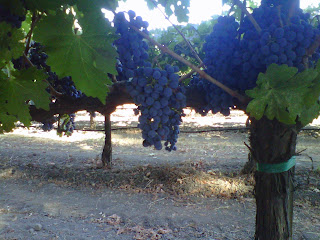Cabernet Sauvignon
Cabernet Sauvignon is easy and difficult at the same time to discuss. It is a grape that is seen in the royal family of grapes, maybe even the king. Like Merlot it is a common international grape that comprises quality bottles the world over. Ever had a wine from Israel, or how about China? Believe it when I say the first one you do eventually have if you said no will probably be Cabernet Sauvignon. Both countries are beginning to produce quality examples of the varietal.
The vine itself is fairly rugged. It is a late ripening variety, and so it will thrive in a variety of climates from moderate and semi-coastal, like Bordeaux, to warm areas where it usually has no problems coming into full ripeness, like Napa Valley or Australia. The bunches are of a normal cluster size, and the berries (the individual grapes) are fairly small with a naturally thick skin. Remember tannins and colors come from the skins, hence why Cabernet Sauvignon is the way it is. The resulting wine from the juice pressed is often aged in oak barrels to add complexity to the wine and increase the essence of the tannins. Mostly the wine is strong enough to withstand longer periods of time in barrels for aging and refinement. Cabernet Sauvignon is a versatile wine as well; it can stand alone as a pure varietal but is often blending with a wide array of grapes.
Let me begin with Bordeaux, the birthplace of Cabernet Sauvignon, literally. It has been determined that its parents are Cabernet Franc and Sauvignon Blanc. The vine is the celebrity of the Left Bank, the Haut-Medoc down into the northern Graves as well. In Bordeaux though, a temperamental moderate climate, blending is not only a necessity but a law. It is one of the last ripening grapes of the area, and so growers have Merlot and Cabernet Franc in the vineyards as well. In any given year the Cabernet Sauvignon may need to be harvested a few days early to avoid rain, thus the need for the blending grapes to achieve a high quality wine. It is interesting because Bordeaux has such a distinct style, one which is attempted to be duplicated the world over.
If you live in California Cabernet Sauvignon is no stranger to you either. This is the grape that built the fine wine industry. Napa Valley and its western neighbor Sonoma are the stars of the show, and have histories going back over 100 years. The place really to begin though is with Robert Mondavi and his opening of his own winery after Prohibition ended. It was Cabernet Sauvignon that many in both valleys leaned on to be the cash crop. Warmer and more consistent than Bordeaux, in most years there are little problems maturing the Cabernet Sauvignon grapes on the vine. The resulting wines are traditionally stronger and fuller bodied. Today it rivals Pinot Noir as the most popular red wine in California, much like the Bordeaux vs. Burgundy rivalry.
Italy is mostly known for its indigenous grape varietals, but has a long standing tradition with Cabernet Sauvignon as well. It is grown in many different regions form the north to the south, but finds its natural home in Tuscany. It gained its success after the phylloxera epidemic that almost wiped out the European wine industry, as growers were able to replant their vineyards with vines that would be better economically. The ‘Supertuscan’ phenomenon that began its craze in the early 1970’s is Cabernet Sauvignon driven. Even to this day ‘Supertuscan’ wines are some of the most prestigious and sought after wines in all of Italy. Sassicaia, Ornellaia, and Antinori’s Guado al Tasso are but a few examples. The region of Bolgheri in the Northern Maremma is the heart of the Cabernet Sauvignon vine in Italy. It thrives here and the growing number of producers and investment in the area is a testament to this.
Australia is definitely Shiraz country, being the thriving red varietal of the continent, but Cabernet Sauvignon not only does quite well but has a very prestigious history. The regions tend to be very warm and thus you get a wine that is very dark and rich, warm in flavors and a bit fleshy to boot, but very refined examples do exist. The most famous use of Cabernet Sauvignon in all of Australia is by the most well known and one of the oldest wineries in the place, Penfold’s. Their flagship wine, Penfold’s Grange is a blend of Cabernet Sauvignon and the noble Shiraz. It was created many years ago to rival the Bordeaux style and has done quite well throughout its time. Today it can boast the reputation of one of the most sought after wines in the whole continent. A great wine that balances the power of the two varietals amazingly.
Other major countries or regions of note for Cabernet Sauvignon are vast, in that it is so widely circulated. Chile in South America makes some great bottles, as does Spain. Washington State is better known for its Merlot, but makes some top quality examples as well. Also, a bit of a curveball, one of my favorite Cabernet Sauvignon based wines comes from Chateau Musar in Lebanon. Take the opportunity to search out a properly aged Musar and you will not be disappointed. Or pay for dinner, and I’ll bring one of mine!


No comments:
Post a Comment